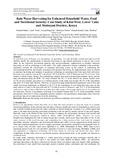Rain water harvesting for enhanced household water, food and nutritional security: case study of Kitui west, lower Yatta and Matinyani districts, Kenya

View/
Date
2014Author
Makau, Wambui
Gitau, Ayub
Mugachia, Joseph
Ocharo, Robinson
Kamau, Hannah
Wambua, Judy
Luvai, Allois
Language
enMetadata
Show full item recordAbstract
In semi-arid areas of Kenya, over dependence on agriculture, low and unreliable rainfall and high livestock numbers, justify the considerations of rainwater harvesting for agricultural production. A step by step is now taken by the respective government agencies and non-governmental organizations to promote rainwater harvesting, as well as promoting it to the public. This study conducted a focused evaluation of the residents’ experience towards the effectiveness of rainwater harvesting system in the context of minimizing the environmental problems, the benefits associated with rainwater harvesting, the implementation issue in relation to rainwater harvesting and adoption of greenhouse technology as a paradigm shift from open field cultivation. Research was conducted among 387 respondents: 109 in Kitui West, 104 in Matinyani and 124 in Lower Yatta districts of Kitui County, Kenya. The methodology adopted used semi-structured questionnaire survey and the data was analyzed using the SPSS. The study revealed that 56.3 % of the families are female- headed while 43.7% are male headed. Agriculture is a common practice in the study area because 90.4 % of the respondents had above ½ of their lands utilized. However, it is practiced using traditional farm implements such as hoes and simple harvesting implements as affirmed by 46.3 % of the respondents. It was found that water pans are the main sources of water in the area with only 67.2 % able to access it. However, only 55.2 % of the households could access water of above 200 liters on a daily basis and owing to the average family size of 4-6 members in the study area. The use of greenhouse technology is not popular because only 11.3 % of the respondents owned greenhouses while 85.8 % of the respondents said they wanted to own greenhouses. Surprisingly, those who own greenhouse have never made money from this technology.
URI
http://www.iiste.org/Journals/index.php/JEES/article/view/14502http://hdl.handle.net/11295/80550
Publisher
University of Nairobi
